Part Time Course
Saturdays
9.30am- 4.30pm
Total of 37 weeks of tuition
Deposit = £200
Cost = £975 per term (3 terms per course)
Limited to 10 Students
£200.00
3 in stock
Part Time Course
Saturdays
9.30am- 4.30pm
Total of 37 weeks of tuition
Deposit = £200
Cost = £975 per term (3 terms per course)
Limited to 10 Students
3 in stock
You’ve spent hours trying to capture a likeness, but something always feels off. Maybe the proportions don’t quite match, or the shading flattens instead of bringing your subject to life. You admire the effortless realism of master portrait artists and wonder:
“How do they do it? And why do my portraits look nothing like that?”
If you’ve ever felt frustrated by your progress or unsure how to improve, you’re not alone. The truth is, portrait painting isn’t about talent—it’s about learning the right techniques. And that’s exactly what we teach in the Academy Portrait Painting Course.
Previous Graduates Recent Work
Many artists struggle because they guess rather than measure. In the first part of the portrait painting course, you’ll develop precision in drawing using classical methods.
By the end of this stage, you’ll finally understand why past portraits didn’t work—and how to fix them.
Ever painted a portrait that looked great in black and white, but turned muddy when adding colour? That’s because many artists jump into colour without first mastering tonal relationships.
By the end of this 40-week portrait painting course, you’ll not only be painting realistic, expressive portraits, but you’ll also gain the confidence to work independently—whether in a studio or with live models.
Imagine the moment when you finish a portrait and see the likeness staring back at you. No more frustration, no more struggling—just a clear, proven process that works.
Ready to finally master portrait painting?
Judith Booth joined the course as a relative beginner. Below is a drawing she did before starting, alongside her final portrait—a testament to her incredible progress.
Through dedication and disciplined practice, she followed the course structure, completed every assignment, and achieved remarkable results. Her transformation speaks for itself.

” I have thoroughly enjoyed my year on the Realist Academy painting course. I realised that I needed expert help to improve my portrait skills and the course really delivered. As a complete beginner I felt comfortable with the well structured approach taught by Louis. Assignments done each week were essential in practicing the skills learned in class. I’m really proud of the portraits I have managed to produce during the course and one of them won first prize in an art exhibition. Something I would never have dreamed of a year ago! I would recommend the course to anyone wishing to improve their portrait skills or learn from scratch.”
Judith Booth
” Joining and completing the Portrait Painting course was one of the best decisions I have made, following Louis’ guidance I was able to improve my painting as well as drawing skills which are essential for delicate portrait work. Lending his vast knowledge and experience has allowed me to get a firm grasp of colour theory as well as being able to analyze my own work critically to make adjustments and improvements.
The limited number of seats and structure of the course allowed Louis to focus on each student and give them ample attention and the studio was packed with technology and innovations which allowed me to learn and understand things at a much faster rate than I would have if I was studying by myself.
Other than that, Louis is a great teacher with a fantastic character and he always goes the extra mile.”
Tom Kielski
The Portrait Painting Course is thoughtfully divided into two essential parts: Tone and Colour. The first part of the course covers Tone is divided into, Drawing and Tone.
In the second part of the Portrait Painting Course, we’ll dive deep into the theory and practical application of colour. You’ll explore the Full Colour Palette, which is perfectly suited to the Alla Prima style of painting, known for its fresh, vibrant finish.
Studying masterpieces is the fastest way to build a strong visual vocabulary. This term, we’ll be focusing on some of the modern masters of the Alla Prima technique, providing invaluable insights into handling the complexities of a full palette.
By learning from these masters and applying their techniques, you’ll begin to develop your unique style as a portrait artist.
The next step is tone, we will be learning how to observe and describe 3-dimensional form without the distraction or complexity of colour.
Simplification is key, we start by using the model of the Asaro head as an armature to break down the features of the face into simple geometric planes. Training the eye to accurately compare the tonal relationships of each plane is crucial to painting a convincing portrait.
All images below are taken from Louis Smiths demonstrations in front of the class when delivering each lesson.
The secret to a successful painting is measuring tone and colour in that order.
First we start with the Sight Size technique which is copying the reference like for like. Once we are comfortable with this measuring technique we then progress to comparative measurements based on proportional units of measurement, this method is used when observing the model from a distance.
Timetable Portrait Painting Course
19th September 2026 – 17th July 2027
Saturdays, 9.30-4.30
Total of 37 Weeks Tuition
1st Term 19th Sep – 24th Oct | Half Term | 7th Nov – 19th Dec 2026
Christmas Break
2nd Term 9th Jan – 6th Feb | Half Term | 20th Feb – 27th March 2027
Easter Break
3rd Term 17th April – 29th May | Half Term | 12th June – 17th July 2027
Cost, £975 per term (3 terms per course)
Deposit , £200 and the remaining balance of £775 is to be paid 3 weeks before the start of the Academic Year. Details will be sent in the confirmation email.
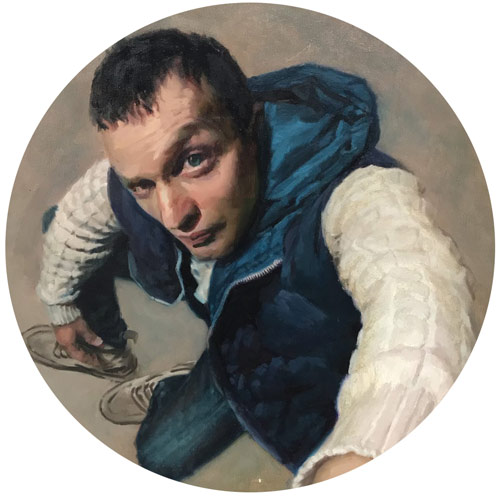
A classically trained portrait artist with years of experience studying in Florence, Louis has helped countless artists break through their creative struggles. With live demonstrations and hands-on guidance, you’ll gain the skills that took master painters years to discover—delivered in an easy-to-follow, structured program.
See his work at: louissmithart.com
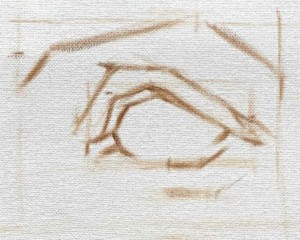
Lesson
Lesson = Students learn how to measure using the Sight Size method, learning how to map the features of the face.
Exercise = Students work from Charles Bargue master copies, then apply this method to the drawing of each feature.
Model = Charles Bargue master copies and photo references of the features.
Homework = Articulate the features of the face.
Outcome
Students will learn:
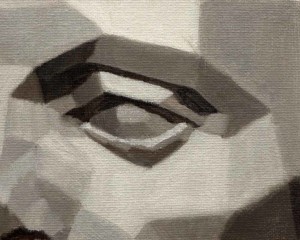
Lesson
Lesson = We will be using the Asaro head as an armature to simplify the features into geometric planes.
Exercise = Learning how to observe and describe form using a step by step process.
Model = Asaro Eye, nose and mouth reference.
Homework = Repeat the steps in class.
Outcome
Students will learn:
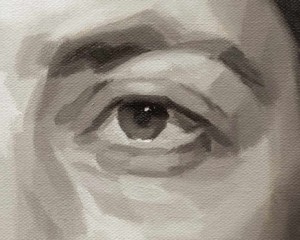
Exercise = Breaking down the form of the eye, nose, mouth and ear into simple planes.
Model = Eye, nose, mouth and ear references.
Homework = Repeat the steps in class.
Outcome
Students will learn:
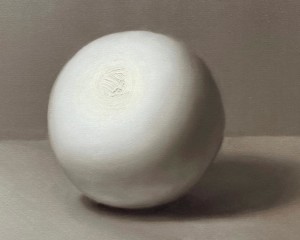
Lesson
Lesson = Understanding the anatomy of light, breaking down the form into its separate tones of highlight, halftone, shadow and cast shadow.
Exercise = Follow the steps listed to illustrate the form of a sphere.
Model = Polystyrene, ball, square and cylinder.
Homework = Repeat the steps in class to illustrate the form of a cylinder.
Outcome
Students will learn:
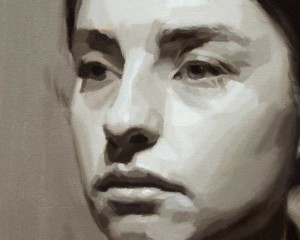
Lesson
Lesson = Put all the main features together to form the triangle of the face. An accurate portrayal of the eyes nose and mouth is important to produce a recognisable face.
Exercise = Working big to small, starting with overall form of head then the features.
Model = Photo reference.
Homework = Practice this technique by painting the head from a different angle.
Outcome
Students will learn:
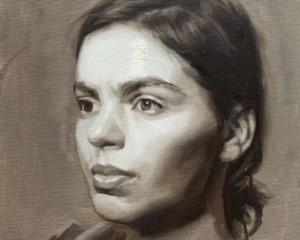
Exercise = Follow the 23 step guide.
Model = Photo reference.
Homework = Repeat all the steps with a different reference photo.
Outcome
Students will learn:
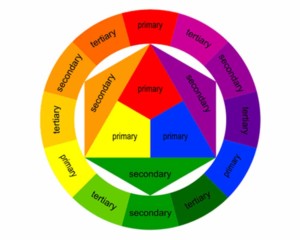
Lesson
Lesson = Understanding Colour. Hue, chroma and value explained. Deeper knowledge of complimentary colour and colour temperature.
Exercise = Colour wheel, mixing secondary and tertiary colours from primary colours. Mixing flesh tones, high chroma – low chroma, warm and cool.
Model = No Model.
Homework = Practice colour mixing exercises.
Outcome
Students will learn:
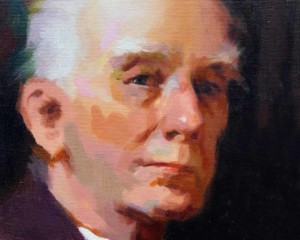
Lesson
Lesson = Richard Shmid is a modern day master of Alla Prima portraits, the aim of this study is to emulate his loose high chroma style.
Exercise = Study a Richard Schmid portrait painting observing the use of colour, strokes and accuracy.
Model = Apply what we have learned with the Model.
Homework = Study Richard Shmid Portrait. Paint a portrait in similar style either sitter or photo reference.
Outcome
Students will learn:
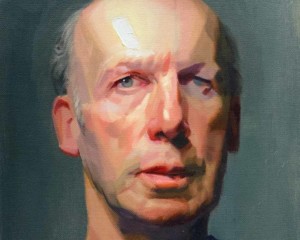
Lesson
Lesson = This Lesson is designed to push the boundaries of colour by assimulating Richard Shmid’s approach to capturing the variety of colour in the face.
Exercise = Study observing the local colours of the face and exaggerated colour mixing.
Model = Referance of Paul.
Homework = Repaint the study to see how much you remember.
Outcome
Students will learn:
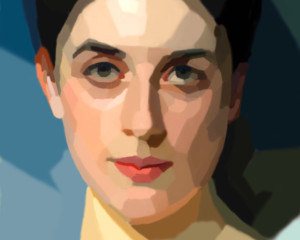
Lesson
Lesson = John Singer Sargent master copy. Now we are starting to refine the colours of the face by copying Sargents lowere chroma colours.
Exercise = Break down the portrait in to simple planes of hue, chroma and value used by Sargent
Model = Lady Agnew portrait.
Homework = Repeat the exercise with another master copy.
Outcome
Students will learn:
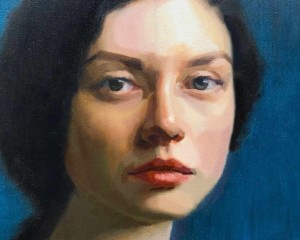
Lesson
Lesson = This lesson is designed to observe and describe the subtlety of colour and tonal relationships by assimulating Sargents approach.
Exercise = Lower the chroma and maintin the planes to describe the form of the face.
Model = Referance of a young girl..
Homework = Repeat the exercise.
Outcome
Students will learn:
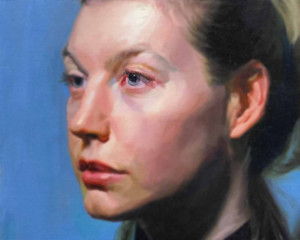
Lesson
Lesson = Softening edges, still observing the planes of the face but refining the variety of edges as when rendering each plane.
Exercise = Observing the variety of edges of each plane ranging from sharp to soft.
Model = Using a portrait model and reference.
Homework = Work on the portrait in their own time.
Outcome
Students will learn:
You must be logged in to post a comment.
I completed the 1 year painting programme in 2017/8 and believe I made major progress with my work under Louis’ guidance. Other artists, relatives and friends are amazed at the new level and quality of realism achieved.
Nick Bailey, Sept 2018.
My drawing ability hit a wall, where I knew things were not right but was not able to identify why. I did one of Louis’s Alla Prima weekends, someone who actually taught you. This opened a door to painting portraits and colour. Forgetfulness and fear stopped progress so I booked for the painting course, one of my better decisions in life.
On the course, Louis teaches you everything you need to know, how to represent form, what materials to use and techniques to paint. It is an outlay in time, effort and money. The cost is modest, the guidance invaluable. You have one of the best artists as your teacher. The course is hard work. You must do the exercises, but will be rewarded with what you can achieve. I watched all of us on the course progress significantly. I recommend that you have a go, with the weekends if you can’t manage the full course. Best wishes at Walton Hall.
Thanks, Peter
I decided to attend The Realist Academy as I felt I had plateaued with my artwork. There were elements that I really wanted to work on and though I primarily work digitally I felt that learning to paint realism in a traditional manner would improve my overall abilities. I was never strong at realism and had never touched oils before so I was nervous about how I would do, but Louis has a work along with him method of teaching that eases you in to his painting system. My draftsmanship, observational skills and understanding of light colour and form got a massive boost from attending the classes, honestly as a move to improve my abilities and for my artistic development it was one of the best choices I have made. Going back to working digitally after taking the course I can see a massive improvement in every area. I would say whether you intend to work exclusively in oils or not that this painting course is more than worth your while.
Mark Penman
Since retiring from work Iv wanted to learn how draw and paint properly. I was studying fine art at University but left after a year to attend the Painting Program at the Realist Academy. I was apprehensive about making the right decision but once I was on the course I found that Louis made us all very welcome and the learning process was clear and straight forward from the start.
The biggest worry during the program was how the lessons would continue during the Covid Lockdown. Credit to Louis for being able to adapt and maintain the momentum of the class while teaching us online.
Being taught online was very daunting for me at first but I soon got the hang of Zoom and found it had its advantages.
Louis changed the structure of the class from a full day into two half days spread across the week which I found worked better for me as it was less taxing and helped to keep me motivated throughout the week. Another benefit was being able to see Louis up close mixing the colours on the palette and how he applied them on the canvas, it saved trying to peer over peoples shoulders to see what’s happening as Im not that tall.
Having experienced the course in person and online I would say both have their advantages. I started this course knowing little about painting in oils and now feel I have firm grounding to apply my knowledge to other disciplines.
Pat Murrell
As an experienced artist, through out my life I have found that i reach plateaus in my abilities and knowledge and these plateaus are hard to break free from. So to find a person who has the ability and knowledge to help push through these issues is rare.
I have over the years sought tutor-ledge with artist from all over the world through videos, online courses and workshops but what all these lacked was long term face to face tailored critiques.
We can push ourselves constantly beyond where we think our limits lie with practice and learning but without independent mentorship it can be wasted.
Louis has design a roadmap to better knowledge, technique and artistry. Each module starts with basic skill building techniques and each next stage builds on the one before. This process helped me to quickly identify my short comings to work harder on whilst building my skills and knowledge.
I feel after 12 months of committing a few hours a week and applying myself I have achieved the goals I set myself. I now have an Arsenal of techniques and knowledge to take me to the next level. Watch this space 😉
John Clark
We were warned at the start of the year that the course will be over in a flash. The instructions were simple, follow the instructions and do the homework. I wish I had done just that, I didn’t realize until towards the end how much more I could have improved.
As a member of the Association of Animal artists I have exhibited but had no prior formal training .
I love watching Portrait Artist of the year and wanted to try my hand portrait painting. After a poor attempt at painting Bryan Ferry I decided to do something about it. Enrolling on this course with the Realist Academy was the best decision I could have made.
I highly recommend it to anybody who wished to progress to a high standard. Please be prepared for the truth . (Yes it hurts sometimes but that’s how you learn and move on .) Louis will guide you expertly through the stages .(He did have to repeat them several times for us oldies, but we got there eventually !!)
This year has been challenging as we started as a Group class at Walton Hall but then had to change to working from home due to lockdown.
Louis has worked tirelessly to ensure the class continued and we were able to complete the course online. Val Orme
I really enjoyed my year studying under Louis. It is certainly as challenging as it is fun, and I have learnt so much about academic portrait painting. Louis is very approachable and knowledgeable, and my fellow students were lovely people. Louis has opened my eyes to portrait painting in a way that I could never have imagined possible.
Andrew Wall
I have a BA Honours in Fine Art. This approach is the opposite of my contemporary art education. I didn’t feel as though there was the space to express myself freely. There was too much discipline for my liking.
It’s a time commitment which I struggled with but in the end it was well worth it.
I started painting during lock down, wanted to take it further and luckily found this course. I think it can save years of doing things wrong, its worth the money if its going to save a lot wasted time and effort.
The course is great for anyone serious about learning. Louis Smith is an excellent artist and teacher. I struggled at times, but got through with the support of Louis and the group and found it to be highly rewarding. He teaches a step by step approach suitable for beginners to experienced artists. The critiques are detailed and insightful and he never gives false praise. He teaches not only drawing and painting skills but also how to manage your time. I’ve gone from wishing I could paint to understanding the process and having a solid foundation to build on.
As a self-taught artist I had been mulling over taking this course for over 6 years – the time commitment was holding me back.
I am so glad that I cleared space and committed to the class, I thrive with in-person tuition and this course was disciplined, taking me through all the technical fundamentals that being self taught I simply didn’t have.
I’ve been fascinated by portraiture since a teenager however my attempts (in pastels and pencils) have been inconsistent, some ok, some most definitely not ok!
Thanks to Louis’s tuition I now understand the fundamentals and can apply them to my art – my portraiture has improved 100% and is now of a consistently high standard, so m much so that I am now taking commissions.
Like all courses you get out what you put in and you need to be prepared to not only go to all the lessons but also to set aside enough time to complete the homework too which can be up to a day.
The only reason I marked down the venue was the fact that it’s a bit of a trek to the loos and for a few months they were closed (we had access to another one further away) on good days this is no issue but in winter… not so fun.
Top tip – wear a name badge, Louis is rubbish at remembering names! lol
This is one of the paintings I completed towards the end of the class – I’m really proud of it!
Hi Su, thanks for the feedback. Yes unfortunately the toilets are out of my control as Walton Hall is run by Warrington Council so things take time to resolve.
Thanks Louis
Having accrued many bad habits in painting, in attending the Realist Academy I successfully eliminated these bad practices and totally put my skillset on the right trajectory.
“Before I started the course I was unhappy with the standard of my work. However after a year training with Louis (who is a highly skilled individual) I am pleased to see an improvement in my technical abilities and the quality of my work has improved.I highly recommend the in studio approach, it is invaluable to improve, as the tutor is there to point out where you are going wrong instantly, instead of taking hours or weeks trying to figure things out on your own. The principles and steps which Louis teaches helps to instil a structured, methodical way to painting. You won’t find a better foundation to Portrait painting in the North of England than at The Realist Academy.”Adrian Beamish
I have just completed the 1 year portraiture course at the Realist Academy and I have really enjoyed it. Under Louis’ expert tutelage my portraits have improved tremendously and although the course is very structured, it is delivered in a relaxed and friendly atmosphere in a well equipped studio. The homework set each week was an essential opportunity to practice at home the skills learned in class, followed by constructive criticism by Louis in the studio. I would highly recommend this course to anyone who wishes to improve their painting skills, beginners or experienced artists alike. Lynne Forshaw
‘I have just finished the part time portrait painting program 2022-2023 at Realist Academy with Louis Smith. The course is well structured and takes you step by step through each stage so you gradually learn and understand the techniques that are essential to create beautiful portraits.Louis is a brilliant artist and he’s very generous in sharing his knowledge with his students. Louis always knows where you are in the painting process and how to take you to the next step and gives very informative demonstrations.I began the course as a beginner but finished a much more proficient artist, having gained knowledge and skills it would have taken me years to develop on my own.’ Alina H.
Joining and completing the Portrait Painting course was one of the best decisions I have made, following Louis’ guidance I was able to improve my painting as well as drawing skills which are essential for delicate portrait work. Lending his vast knowledge and experience has allowed me to get a firm grasp of colour theory as well as being able to analyze my own work critically to make adjustments and improvements.
The limited number of seats and structure of the course allowed Louis to focus on each student and give them ample attention and the studio was packed with technology and innovations which allowed me to learn and understand things at a much faster rate than I would have if I was studying by myself.
Other than that, Louis is a great teacher with a fantastic character and he always goes the extra mile 🙂
I attended the 2023-2024 in person academy class. I could not draw people before I started this course, and I had never used oil paints before. I can not believe how far I have come in a year. In the first few sessions Louis teaches you about proportions and measuring so you can begin to accurately draw a face.
He is very patient and spends time with each student covering homework and class work. He covers theory as well as practical work, including light, perception and colour theory as well as looking at the biology of the face, allowing you to really understand what you are painting.The course requires commitment and hardwork, and you will definitely get out of what you want to put in.
It was absolutely worth every penny. I also got to meet a wonderful group of people who were completing the course with me.
An amazing course, learnt so many new skills and felt a lot more confident in using oils by the end of the year.
I attended the physical art class with Louis 2023-2024. I live in Cumbria and made the 1.5 hour journey to Warrington every Saturday morning. The day was long but the trade off in my artistic growth was worth it.I thoroughly enjoyed studying under Louis expert tuition and my painting and drawing skills have vastly improved. Louis is awesome at colour mixing and was a great at helping me to achieve realism in my paintings.I had used oil paints before but I gained a deeper knowledge in their application and the various mediums used for various effects.I finally got to grips with comparative measuring as I was sick of drawing wonky portraits.Louis is very patient with his students and is always very helpful in steering us back on track.The group I attended with were fab also and I loved the banter. I look forward to attending in the new term as I will be continuing my drawing and painting studies under Louis .There were no negatives for my experience but I would advise you take a packed lunch as the queue in cafe below can get very long.
I did the portrait course and learnt an enormous amount. It was a brilliant course, you don’t learn this stuff at university. The atmosphere was relaxed and enjoyable, Louis is a great tutor.